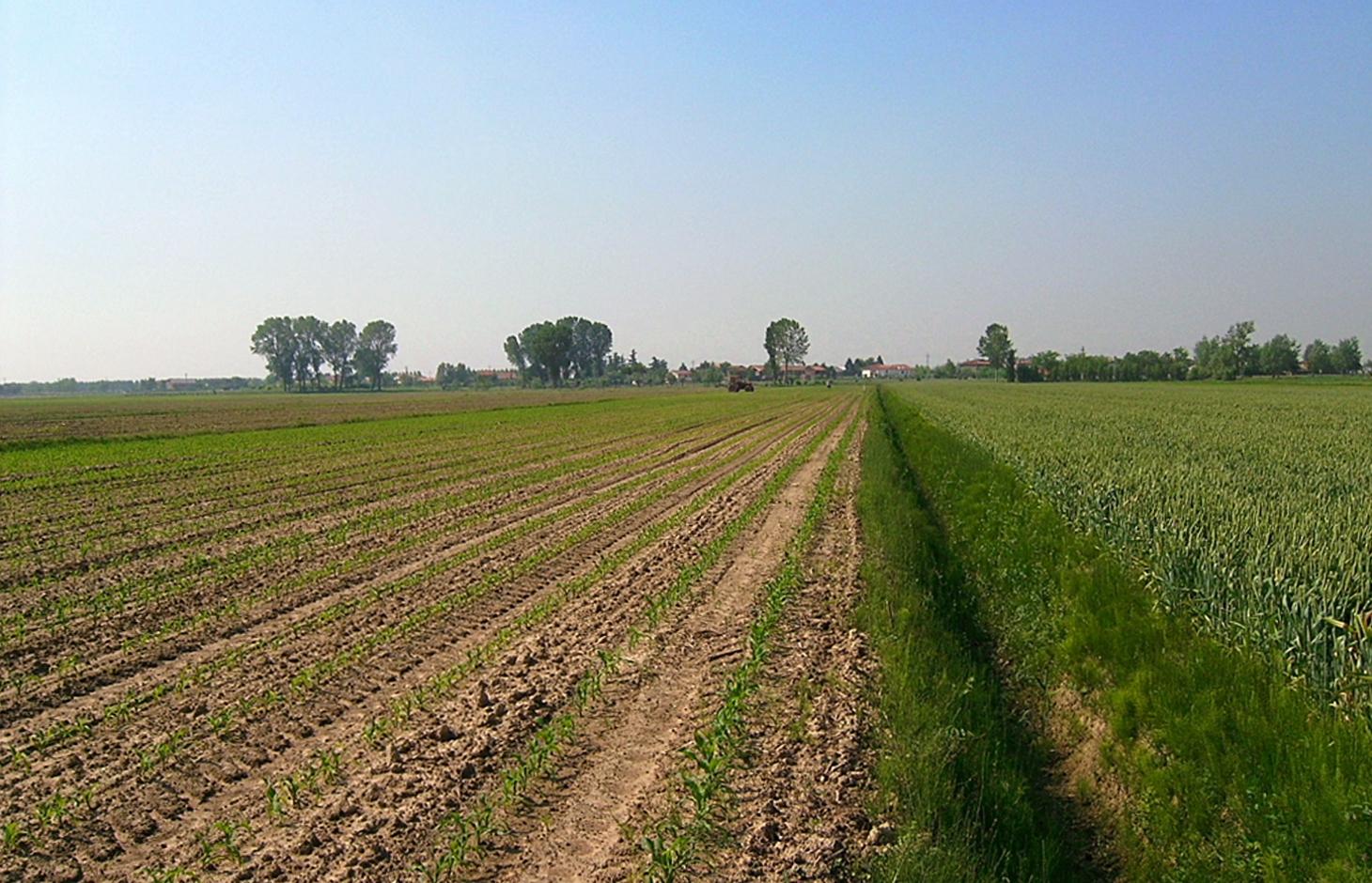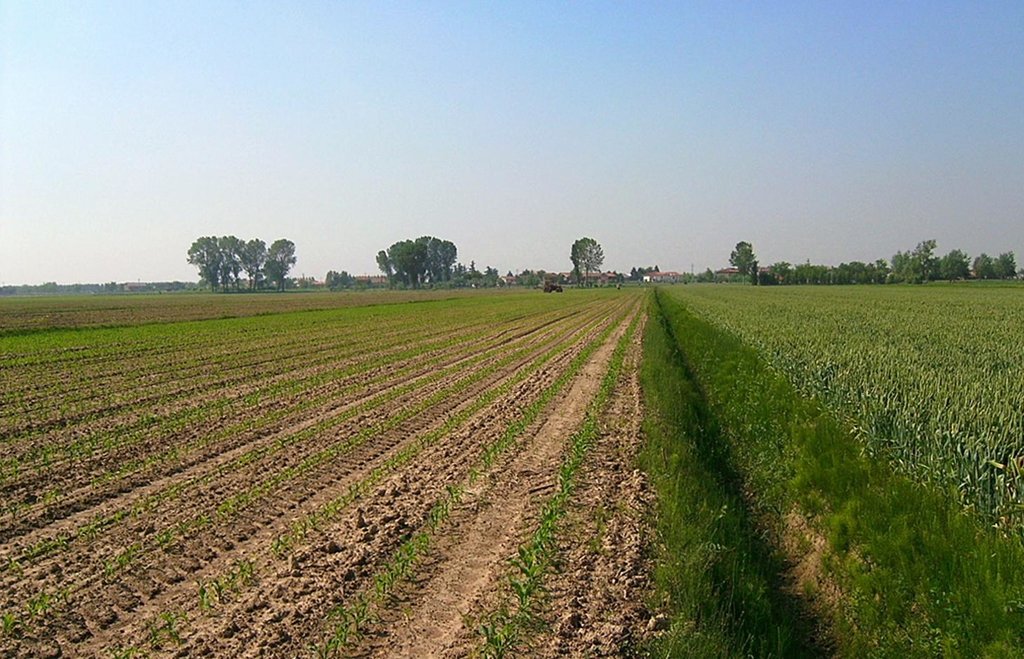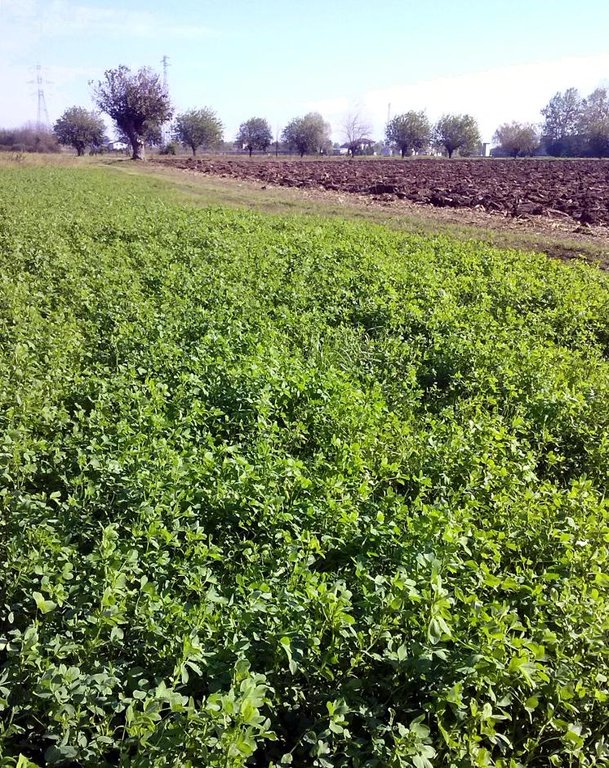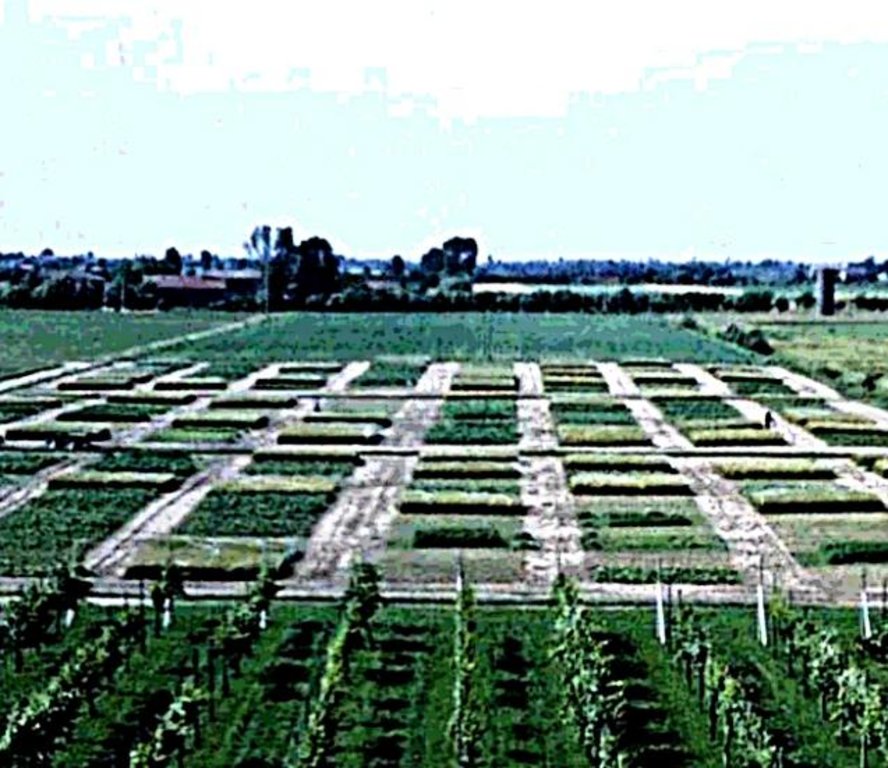Crop rotation with legumes [意大利]
- 创建:
- 更新:
- 编制者: Nicola Dal Ferro
- 编辑者: –
- 审查者: Fabian Ottiger
Rotazione delle colture
technologies_1227 - 意大利
查看章节
全部展开 全部收起1. 一般信息
1.2 参与该技术评估和文件编制的资源人员和机构的联系方式
SLM专业人员:
Morari Francesco
francesco.morari@unipd.it
University of Padova
Via 8 Febbraio 1848, 2, 35122 Padova PD, Italy
意大利
有助于对技术进行记录/评估的项目名称(如相关)
Preventing and Remediating degradation of soils in Europe through Land Care (EU-RECARE )有助于对技术进行记录/评估的机构名称(如相关)
University of Padova (UNIPD) - 意大利1.3 关于使用通过WOCAT记录的数据的条件
(现场)数据是什么时候汇编的?:
20/10/2014
编制者和关键资源人员接受有关使用通过WOCAT记录数据的条件。:
是
2. SLM技术的说明
2.1 技术简介
技术定义:
Crop rotation as an alternative to monoculture practices to improve soil fertility and reduce soilborne diseases
2.2 技术的详细说明
说明:
Crop rotations in Veneto region, particularly in the low Venetian plain where agriculture is mainly concentrated, is diversified and based on the needs of each farmer. However most rotation systems are confined to time limits of six years or less, providing a succession of spring (generally maize, soybean, sorghum) and winter crops (wheat, rapeseed, barley). Legumes play a pivotal role on crop rotation due to their richness in protein for both man and breeding. Using legumes in the crop rotation favour the fixation of atmospheric nitrogen and bind it into the soil with a significant increase of soil fertility.
Purpose of the Technology: Crop rotation has the ability to control weeds and break pest cycles reducing the use of pesticides. Diversification of crop production increases soil and ecosystem biodiversity promoting the stability of agricultural systems. The introduction of legumes in crop rotation enhances nutrient availability and generally soil quality.
Establishment / maintenance activities and inputs: Crop rotation can be adjusted to the needs of farmers and can be adopted without significant investments and further costs. A typical crop rotation provides for the succession of deep-rooting crops (e.g. maize), winter wheat and finally soybean, which contribute to the re-establishment of soil fertility. Moreover the system allows a better distribution of labour throughout the year.
Natural / human environment: Crop rotation has many agronomic and environmental benefits compared with monoculture cropping. The increase of soil and agro-ecosystems biodiversity has positive effect on its resilience, promoting its capacity to respond to natural and anthropogenic perturbation. From an environmental point of view, the introduction of legumes favours a reduction of chemical inputs, with significant benefits for surface and groundwater quality.
2.3 技术照片
2.5 已应用该技术的、本评估所涵盖的国家/地区/地点
国家:
意大利
区域/州/省:
Italy
有关地点的进一步说明:
Low venetian plain of veneto region
2.6 实施日期
如果不知道确切的年份,请说明大概的日期:
- 50多年前(传统)
2.7 技术介绍
详细说明该技术是如何引入的:
- 作为传统系统的一部分(> 50 年)
3. SLM技术的分类
3.1 该技术的主要目的
- 改良生产
- 减少、预防、恢复土地退化
3.2 应用该技术的当前土地利用类型

农田
- 一年一作
主要农作物(经济作物及粮食作物):
Major cash crop: Maize
Other crops: Wheat, Soybean
注释:
Major land use problems (compiler’s opinion): Soils in the low Venetian plain of the Veneto region generally suffer from a loss of soil organic matter (SOM) that is strongly affected by their natural texture and climatic conditions. Moreover, in the last 50 years intensive tillage practices contributed to a further SOM decrease estimated at 0.02-0.58 t/ha/y of carbon and high intensive monoculture practices implied oversimplification of agro-ecosystems and decline of soil biodiversity.
Major land use problems (land users’ perception): Decrease of productivity. However to date, few farmers have adopted conservation practices in order to reduce a decline of soil fertility and water quality, symptom of poor perception of the problem.
3.3 有关土地利用的更多信息
该技术所应用土地的供水:
- 混合雨水灌溉
注释:
Water supply: Also rainfed, full irrigation
具体说明:
Longest growing period in days: 210 Longest growing period from month to month: March to OctoberSecond longest growing period in days: 180
3.4 该技术所属的SLM组
- 轮作制度(轮作、休耕、轮垦)
3.5 技术传播
具体说明该技术的分布:
- 均匀地分布在一个区域
如果该技术均匀地分布在一个区域上,请注明覆盖的大致区域。:
- 1,000-10,000 平方千米
3.6 包含该技术的可持续土地管理措施

农艺措施
- A2:有机质/土壤肥力

管理措施
- M2:改变管理/强度级别
注释:
Main measures: agronomic measures
Secondary measures: management measures
Type of agronomic measures: rotations / fallows
3.7 该技术强调的主要土地退化类型

化学性土壤退化
- Cn:肥力下降和有机质含量下降(非侵蚀所致)

生物性退化
- Bl:土壤寿命损失
- Bp:害虫/疾病增加,捕食者减少
注释:
Main type of degradation addressed: Cn: fertility decline and reduced organic matter content, Bl: loss of soil life, Bp: increase of pests / diseases, loss of predators
Main causes of degradation: soil management (lack of organic input with fertilisations), population pressure (High demand for agricultural products and competition for land in densely populated area)
Secondary causes of degradation: crop management (annual, perennial, tree/shrub) (crop monoculture instead of crop rotation)
3.8 防止、减少或恢复土地退化
具体数量名该技术与土地退化有关的目标:
- 防止土地退化
- 减少土地退化
注释:
Main goals: mitigation / reduction of land degradation
Secondary goals: prevention of land degradation
4. 技术规范、实施活动、投入和成本
4.1 该技术的技术图纸
4.2 技术规范/技术图纸说明
Crop rotation experiment established at the University of Padova (1962) including a comparison of monocultures and true rotations (two-year, four-year, six-year). Cropping systems include maize, wheat, soybean, alfalfa, sugar beet.
Location: Legnaro. Padova - Italy
Technical knowledge required for field staff / advisors: low
Technical knowledge required for land users: high
Main technical functions: increase in nutrient availability (supply, recycling,…), spatial arrangement and diversification of land use
Secondary technical functions: increase in organic matter
Rotations / fallows
Material/ species: Cereals, Legumes, Brassicaceae
4.3 有关投入和成本计算的一般信息
其它/国家货币(具体说明):
Euro €
注明美元与当地货币的汇率(如相关):1美元=:
0.8
注明雇用劳工的每日平均工资成本:
21.00
4.4 技术建立活动
注释:
No initial investment
4.6 维护/经常性活动
| 活动 | 措施类型 | 时间/频率 | |
|---|---|---|---|
| 1. | Tillage | 农业学的 | |
| 2. | Seedbed preparation and sowing | 农业学的 | |
| 3. | Fartilisations | 农业学的 | |
| 4. | Weed control | 农业学的 | |
| 5. | Harvesting | 农业学的 |
4.7 维护/经常性活动所需要的费用和投入(每年)
| 对投入进行具体说明 | 单位 | 数量 | 单位成本 | 每项投入的总成本 | 土地使用者承担的成本% | |
|---|---|---|---|---|---|---|
| 设备 | Tillage | ha | 1.0 | 190.5 | 190.5 | |
| 设备 | Seedbed preparation and sowing | ha | 1.0 | 190.5 | 190.5 | |
| 设备 | Weed control | ha | 1.0 | 89.0 | 89.0 | |
| 设备 | Harvesting | ha | 1.0 | 153.0 | 153.0 | |
| 植物材料 | Seeds | ha | 1.0 | 190.5 | 190.5 | |
| 肥料和杀菌剂 | Fertilizer | ha | 1.0 | 406.0 | 406.0 | |
| 肥料和杀菌剂 | Biocides | ha | 1.0 | 125.0 | 125.0 | |
| 技术维护所需总成本 | 1344.5 | |||||
4.8 影响成本的最重要因素
描述影响成本的最决定性因素:
Costs consider a three-year crop rotation with a succession of maize, wheat and soybean. There are not establishment inputs and costs because all the costs are recurrent. Main expenses are for machinery and fertilisations
5. 自然和人文环境
5.1 气候
年降雨量
- < 250毫米
- 251-500毫米
- 501-750毫米
- 751-1,000毫米
- 1,001-1,500毫米
- 1,501-2,000毫米
- 2,001-3,000毫米
- 3,001-4,000毫米
- > 4,000毫米
农业气候带
- 半湿润
Thermal climate class: temperate
5.2 地形
平均坡度:
- 水平(0-2%)
- 缓降(3-5%)
- 平缓(6-10%)
- 滚坡(11-15%)
- 崎岖(16-30%)
- 陡峭(31-60%)
- 非常陡峭(>60%)
地形:
- 高原/平原
- 山脊
- 山坡
- 山地斜坡
- 麓坡
- 谷底
垂直分布带:
- 0-100 m a.s.l.
- 101-500 m a.s.l.
- 501-1,000 m a.s.l.
- 1,001-1,500 m a.s.l.
- 1,501-2,000 m a.s.l.
- 2,001-2,500 m a.s.l.
- 2,501-3,000 m a.s.l.
- 3,001-4,000 m a.s.l.
- > 4,000 m a.s.l.
关于地形的注释和进一步规范:
Altitudinal zones: 0-100 m a.s.l. (the low Venetian does not exceed 50 m above sea level)
5.3 土壤
平均土层深度:
- 非常浅(0-20厘米)
- 浅(21-50厘米)
- 中等深度(51-80厘米)
- 深(81-120厘米)
- 非常深(> 120厘米)
土壤质地(表土):
- 中粒(壤土、粉土)
表土有机质:
- 中(1-3%)
- 低(<1%)
如有可能,附上完整的土壤描述或具体说明可用的信息,例如土壤类型、土壤酸碱度、阳离子交换能力、氮、盐度等。:
Soil fertility is low-medium
Soil drainage/infiltration is medium
Soil water storage capacity is medium
5.4 水资源可用性和质量
地下水位表:
< 5米
地表水的可用性:
好
水质(未处理):
良好饮用水
关于水质和水量的注释和进一步规范:
Ground water table: <5m (The area surrounding the Venice lagoon (1240 km2) is even below the sea level (down to -2 m) and currently cultivated due to land reclamation. As a result water table is kept artificially low)
Water quality (untreated) is good drinking water (groundwater) and for agriculutral use only (irrigation with surface water)
5.5 生物多样性
物种多样性:
- 中等
关于生物多样性的注释和进一步规范:
High population density, infrastructures and intensive agriculture practices affect the state of biodiversity.
5.6 应用该技术的土地使用者的特征
生产系统的市场定位:
- 混合(生计/商业
- 商业/市场
非农收入:
- 收入的10-50%
相对财富水平:
- 平均水平
个人或集体:
- 个人/家庭
机械化水平:
- 机械化/电动
性别:
- 男人
说明土地使用者的其他有关特征:
Land users applying the Technology are mainly common / average land users
Difference in the involvement of women and men: Farmers in the Veneto region are traditionally males due to historical and cultural reasons.
Population density: 200-500 persons/km2
Annual population growth: 0.5% - 1%
100% of the land users are average wealthy.
5.7 应用该技术的土地使用者拥有或租用的平均土地面积
- < 0.5 公顷
- 0.5-1 公顷
- 1-2 公顷
- 2-5公顷
- 5-15公顷
- 15-50公顷
- 50-100公顷
- 100-500公顷
- 500-1,000公顷
- 1,000-10,000公顷
- > 10,000公顷
这被认为是小规模、中规模还是大规模的(参照当地实际情况)?:
- 中等规模的
注释:
Average area of land owned or leased by land users applying the Technology: Also 15-50 ha, 50-100 ha, 100-500 ha
5.8 土地所有权、土地使用权和水使用权
土地所有权:
- 个人,未命名
土地使用权:
- 租赁
- 个人
5.9 进入服务和基础设施的通道
健康:
- 贫瘠
- 适度的
- 好
教育:
- 贫瘠
- 适度的
- 好
技术援助:
- 贫瘠
- 适度的
- 好
就业(例如非农):
- 贫瘠
- 适度的
- 好
能源:
- 贫瘠
- 适度的
- 好
道路和交通:
- 贫瘠
- 适度的
- 好
饮用水和卫生设施:
- 贫瘠
- 适度的
- 好
金融服务:
- 贫瘠
- 适度的
- 好
6. 影响和结论性说明
6.1 该技术的现场影响
社会经济效应
生产
作物生产
生产故障风险
产品多样性
收入和成本
农业投入费用
收入来源的多样性
工作量
社会文化影响
SLM/土地退化知识
Improved livelihoods and human well-being
注释/具体说明:
In the long-term the technology maintains soil fertility and reduces pest diseases. Moreover, it contriobutes to differentiate yields and markets.
生态影响
土壤
养分循环/补给
土壤有机物/地下C
生物多样性:植被、动物
植物多样性
6.3 技术对渐变气候以及与气候相关的极端情况/灾害的暴露和敏感性(土地使用者认为的极端情况/灾害)
渐变气候
渐变气候
| 季节 | 气候变化/极端天气的类型 | 该技术是如何应对的? | |
|---|---|---|---|
| 年温度 | 增加 | 不好 |
其他气候相关的后果
其他气候相关的后果
| 该技术是如何应对的? | |
|---|---|
| 缩短生长期 | 不好 |
6.4 成本效益分析
技术收益与技术维护成本/经常性成本相比如何(从土地使用者的角度看)?
短期回报:
中性/平衡
长期回报:
积极
6.5 技术采用
在所有采用这项技术的人当中,有多少人是自发地采用该技术,即未获得任何物质奖励/付款?:
- 90-100%
注释:
100% of land user families have adopted the Technology without any external material support
6.7 该技术的优点/长处/机会
| 土地使用者眼中的长处/优势/机会 |
|---|
|
Maintains soil fertility How can they be sustained / enhanced? Targeted funding |
| Enhances nutrient cycling |
| 编制者或其他关键资源人员认为的长处/优势/机会 |
|---|
|
Maintains soil fertility and biodiversity How can they be sustained / enhanced? Encourages the use of legumes |
|
Enhances nutrient cycling How can they be sustained / enhanced? Application of organic manure instead of chemical fertilizers |
|
Reduces external inputs How can they be sustained / enhanced? Encourages the use of legumes |
6.8 技术的弱点/缺点/风险及其克服方法
| 土地使用者认为的弱点/缺点/风险 | 如何克服它们? |
|---|---|
| Doeas not maximise yields and incomes |
| 编制者或其他关键资源人员认为的弱点/缺点/风险 | 如何克服它们? |
|---|---|
| Increases labour constraints | Support farmers on field management |
7. 参考和链接
7.2 参考可用出版物
标题、作者、年份、ISBN:
Productivity and Sustainability of Different Cropping Systems. 40 years of Experiments in Veneto region (Italy), Giardini L., 2004
链接和模块
全部展开 全部收起链接
无链接
模块
无模块





